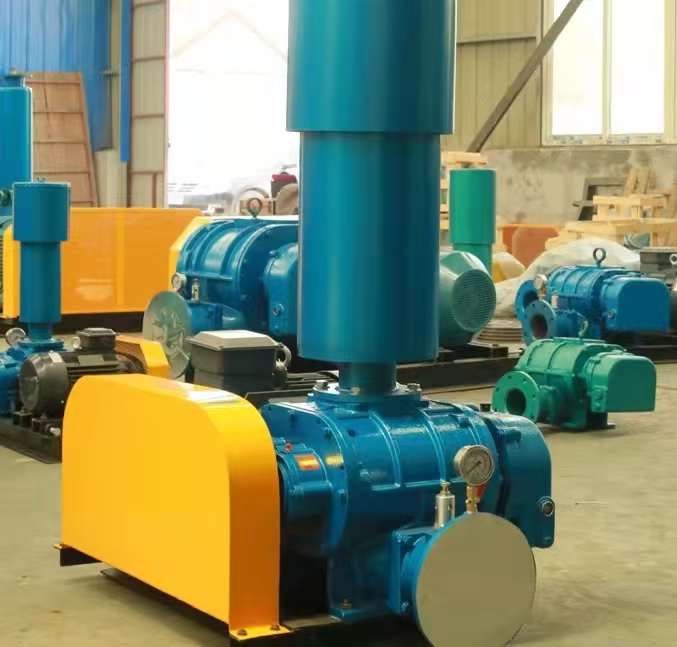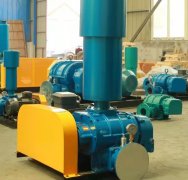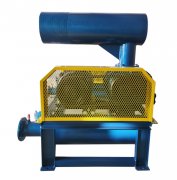The Roots blower is mainly composed of the following core components, each of which plays a critical role in operation. The following is a detailed structural decomposition and functional description:
---

**1. Core components of the host**
|* * Component * * | * * Material/Type * * | * * Function Description * *|
|-------------------|---------------------------|-----------------------------------------------------------------------------|
|* * Rotor * * | Cast iron/stainless steel (2 or 3 blades) | Through synchronous gear meshing, it rotates in the opposite direction to form a closed chamber for transporting gas. The rotor profile affects efficiency and noise|
|Cylinder (casing) * * | HT250 cast iron/stainless steel welding | accommodates the rotor, and the inner wall needs to be precision machined (roughness Ra ≤ 1.6 μ m) to reduce gas leakage|
|* * Synchronous gear * * | 20CrMnTi carburizing and quenching | Ensure that the two rotors rotate synchronously without contact, with a gap of ≤ 0.05mm. The gear accuracy level is usually 5-6 levels (GB/T 10095)|
|* * Bearing box * * | Cast iron shell+self-aligning roller bearing | Supports the rotor shaft to withstand radial/axial loads. Oil cooled bearings can be selected for high temperature conditions|
---
**2. Sealing system**
|* * Sealing Type * * | * * Applicable Scenarios * * | * * Features * *|
|--------------------|-----------------------------------------|-------------------------------------------------------------------------|
|Skeleton oil seal * * | Ordinary air delivery (pressure ≤ 58kPa) | Low cost, easy to replace, with a lifespan of about 6-12 months|
|* * Mechanical seal * * | Toxic/flammable gases (such as coal gas, chlorine gas) | Zero leakage, pressure resistance ≤ 0.3MPa, requires supporting cooling water system|
|Maze seal * * | High temperature dust environment (such as power plant ash transportation) | Non contact, wear-resistant, but allows for trace leakage|
---
**3. Transmission system**
|* * Transmission Method * * | * * Features * * | * * Application Scenarios * *|
|--------------------|----------------------------------------|------------------------------------------|
|* * Direct drive * * | Coupling connection, efficiency>98 | High power fan (>75kW)|
|Belt drive * * | Speed regulation through pulley, efficiency of 90~95 | For medium and small power fans, the tightness of the belt needs to be adjusted regularly|
|* * Gearbox transmission * * | Multi stage speed increase, complex structure | Special high-pressure working conditions (>98kPa)|
---
**4. Auxiliary system**
|* * System * * | * * Key Components * * | * * Functions * *|
|--------------------|--------------------------------------|-------------------------------------------------------------------------|
|Lubrication system * * | Gear oil pump/grease filling nozzle | Bearing and gear lubrication, synthetic grease (such as polyurea based grease) should be used in high-temperature environments|
|* * Cooling system * * | Water cooled jacket/air-cooled fins | Control shell temperature, water-cooled type can cool down by 20-30 ℃|
|* * Silencing system * * | Imported silencer+soundproof cover | Reduce pulse airflow noise (can be reduced from 105dB to below 85dB)|
|* * Protection * * | Pressure relief valve, temperature sensor | Automatic release in case of overpressure, triggering alarm when temperature>90 ℃|
---
**5. Supporting pipelines and instruments**
-* * Intake filter * *: removes particles ≥ 5 μ m (filtration efficiency 99.5), protecting the rotor.
-Elastic joint: reduces pipeline vibration transmission, made of EPDM or fluororubber material.
-Pressure gauge/vacuum gauge: The range should be 1.5~2 times the working pressure, and the accuracy should be level 1.5.
-* * Check valve * *: prevents the rotor from being damaged due to reverse rotation caused by gas backflow during shutdown.
---
**6. Special design variants**
-* * Water cooled Roots blower * *: cylinder with cooling water jacket, suitable for exhaust temperature>150 ℃ working conditions.
-Explosion proof Roots blower: The motor and housing comply with ATEX standards and are used in flammable and explosive environments.
-Corrosion resistant type: made entirely of stainless steel material (such as 304/316L), capable of handling acidic and alkaline gases.
---
**Structural schematic diagram**
```
Inlet → Filter → Muffler → Cylinder (Rotary Compression) → Exhaust → Check Valve → Pipeline
↑ ↑
Synchronous gear ← Bearing box ← Lubrication system
```
---
**Maintain focus points**
1. * * Rotor clearance * *: Regular inspection (measured with a feeler gauge), if the wear exceeds 0.5mm, it needs to be adjusted.
2. * * Gear meshing * *: Check the pitting corrosion on the tooth surface every 500 hours.
3. * * Seal aging * *: If the mechanical seal leakage exceeds 5ml/h, it needs to be replaced.
Mastering these components can solve targeted problems such as fan abnormal noise, leakage, overheating, etc. In actual selection, it is necessary to match the material and sealing scheme according to the characteristics of the medium (such as dust content and corrosiveness).



